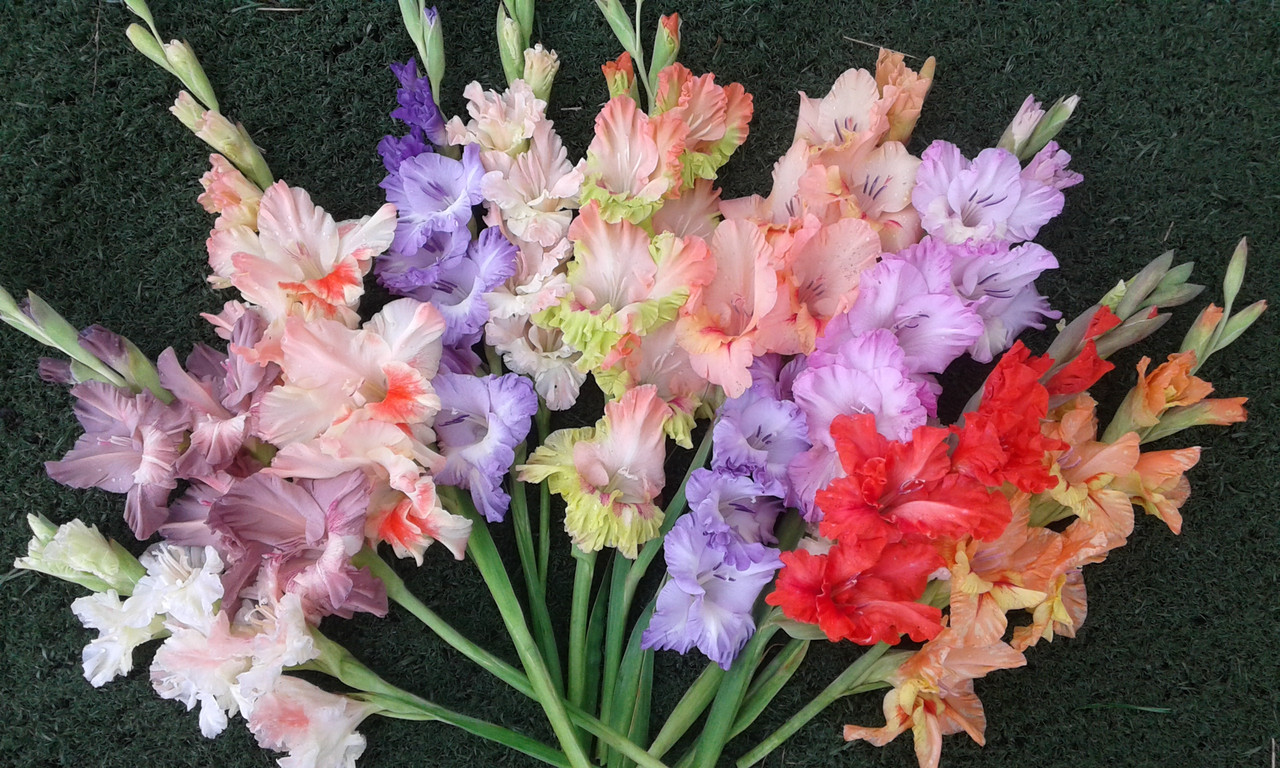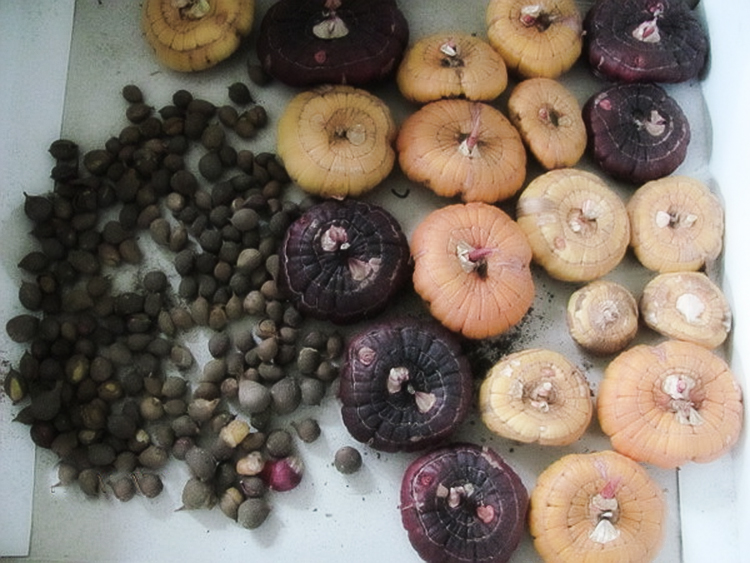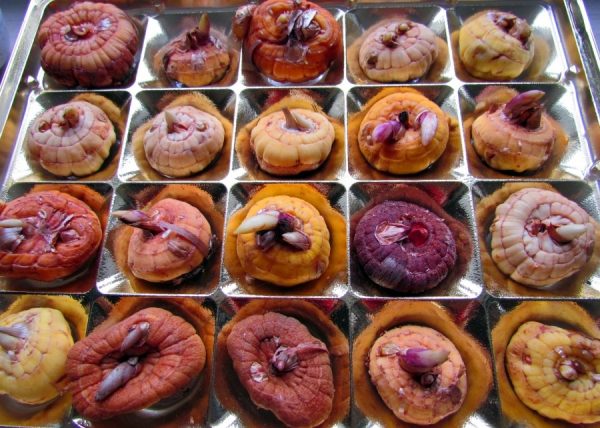Content:
Gladiolus translated from Latin means "sword", its other name is a sword. It belongs to the group of bulbous perennials. It got its name, apparently, for the similarity of long, narrow, slightly pointed leaves at the end with a sword. Africa and Asia are considered the birthplace of gladiolus. The ancient Greeks destroyed the plant, considering it a weed. In ancient Rome, on the contrary, it was "ennobled" and made a decorative ornament of gardens. In addition, the Romans believed in the miraculous power of this flower that protects from misfortune.
Rules for the care of gladioli
Nowadays, gladioli are the most popular flowering plants among gardeners. Breeders have bred about 5000 varieties and hybrids, taking into account climatic conditions and growing methods. What varieties of this elegant representative of the Kasatikov family that decorates any flower garden can not be found, not only all the colors of the rainbow, but also the most bizarre forms.
But to achieve full germination, growth and flowering, you need to make a lot of work. There are a number of rules, the observance of which guarantees success in this matter. Therefore, when planting and caring for gladioli, you must adhere to:
- You cannot grow gladioli in one place for more than two years.
- Buy seeds or bulbs only those that are adapted to the given climate.
- Plant in the ground, observing the rule: deepen the tuber into light soil by four onion diameters, into heavy soil by three.
- Before planting planting material, you need to peel the bulb from the skin, otherwise it will not germinate.
- Gladioli are very fond of light, so you should not plant them in the shade - they may not bloom.
- To avoid fungal diseases, you need to grow flowers in a well-ventilated area.
- If the summer is very hot, then it is necessary to water gladioli every evening, accompanying the action by loosening the soil. In normal summer weather, watering is carried out once a week, but abundantly.
- Proper harvesting and storage of bulbs is the key to getting your own high-quality planting material for flower culture in the new year.
Reproduction of gladioli
How do gladioli breed? There are two ways to reproduce: seeds and babies. For ordinary amateur gardeners, the seed method is ineffective. The fact is that growing gladioli with seeds is difficult and time-consuming. This is usually done by professionals who develop new varieties and hybrids. A completely different matter is the reproduction of a plant from a tuber. Each child will grow up to be an exact copy of the parent. This does not happen with seed reproduction. Seedlings from seeds can not always give the expected result, because they do not retain hereditary characteristics.
Preparation and planting of gladioli in the ground
Every gardener knows how gladioli reproduce. But not everyone is familiar with the rules for preparing the material. First of all, the corms and their children purchased in flower shops or from lovers of corms and their children must be examined, cut off the areas damaged by the disease and cauterized with greenery, carefully peeled off the husk a month before planting.
After preliminary cleaning, the onions are laid out in one layer with the sprout upwards for germination, then they are neutralized in a 3% solution of manganese or basezol for an hour. Children are also preparing for landing. Only sprouted buds are kept in a manganese solution (0.5 grams per 1 liter of water) for 9 hours. This procedure should be carried out 15 days before sowing.
Gladioli planting and care in the open field are associated with the characteristics of the plant. Since gladioli love light and require enough heat, the bed for breeding them is chosen accordingly. What are the requirements for selection:
- Good lighting, no shade.
- Lack of drafts, but sufficient ventilation of the ground.
- Good soil drainage.
- There is no standing groundwater, which means that the site should be with a slight slope.
- Normalization of soil acidity with the help of available tools at hand (chalk, crushed eggshells, dolomite flour).
- Planting in beds where perennial grasses or legumes grew, but not asters, potatoes and other root crops.
Corms are planted in open ground, usually in late April or early May, it all depends on the climatic and weather conditions of the region. Planting is carried out as follows: first, a groove for the bulbs is outlined, then it is filled with water, river sand is poured onto the bottom, in a layer of 2 centimeters, then the tubers are planted to a depth of 8 to 15 centimeters (depending on the size of the bulb) at a distance of 8-10 cm - small, 10-15 cm - large. If there are several rows of gladioli on the flower bed, then there should be at least 20-25 centimeters between them.
Care of gladioli after planting
Taking care of gladioli, like many flowering plants, is quite troublesome. If you regularly follow the care requirements, you can achieve remarkable results in growing flowers. By the end of summer or by autumn, flower beds will delight the eyes and soul for more than one day.
How to propagate and grow gladioli correctly? What recommendations need to be followed:
- First, after the sprouts reach 10 centimeters, sprinkle them with mulch from a layer of humus. It will be a protection against drying out and a good feeding.
- Secondly, watering once a week in the morning or evening hours at 12 liters per square meter, preferably between rows, with obligatory loosening and hilling. On particularly hot days, increase the watering time to twice a week.
- Thirdly, do not forget to tie up the stems, remove dry flowers, and weed the flowerbed with gladioli.
- Fourthly, carry out a three-stage feeding: 1st - nitrogenous (when the first 3 leaves grow); The second - consisting of nitrogen, potassium and phosphorus fertilizers (after the appearance of 5 leaves) and the third - potassium-phosphorus (before the formation of buds).
In addition to root fertilizers, for successful growth and lush flowering, gladiolus needs spraying from aqueous solutions of manganese, boric acid or copper sulfate. In the second half of August, all types of feeding should be stopped.
Cleaning and storing bulbs in winter
Autumn is no less important time than spring, only in terms of cleaning and storing gladioli. You can dig up corms 35-45 days after the appearance of the first color, that is, by mid-September. Before digging them up, you must first cut off the stem with a pruner. Then select large tubers, cut off the roots, shake off the soil, separate the buds and rinse in a sieve under running water. Process the corms in a solution of manganese or foundation, rinse in water and dry for three days. Store in boxes, occasionally turning them over, at a temperature of 18-20 degrees.
Prepare children for winter storage in the same way as adult tubers. But they must be kept at a temperature not higher than 5-6 degrees.
In winter, corms can be stored both in the basement and in the refrigerator (if there is no cellar). This time for all roots is a period of natural sleep, rest, which lasts up to 40 days. In basements, the content of gladiolus bulbs in boxes or boxes with holes will be optimal - ventilation, at a temperature of 10 degrees. Storage is also possible in the refrigerator, in the lower drawer. By the spring, the bulbs will probably shrink slightly. In this case, they can be kept for some time in a growth stimulator (Kornevin, for example).
Growing gladioli in different regions
Growing gladioli in different areas of our vast homeland has its own nuances. Such varieties of gladioli as "Evening Kiev", "Malika", "Prague" are more suitable for the mild climate of the Moscow region. In the Urals and Siberia, with their harsh winters, sharp changes in day and night temperatures, such hardy varieties as Oscar, Washington, Gladiolus Byzantine, Gladiolus Germani and others will better take root.
In modern horticulture, a huge number of varieties and hybrids of these flowers have been bred, both for growing in open ground and for greenhouses. There are instructions on how to propagate gladioli for growing in pots. It doesn't matter if they are Ural, Siberian, Moscow or even Chinese gladioli - they are always beautiful.















